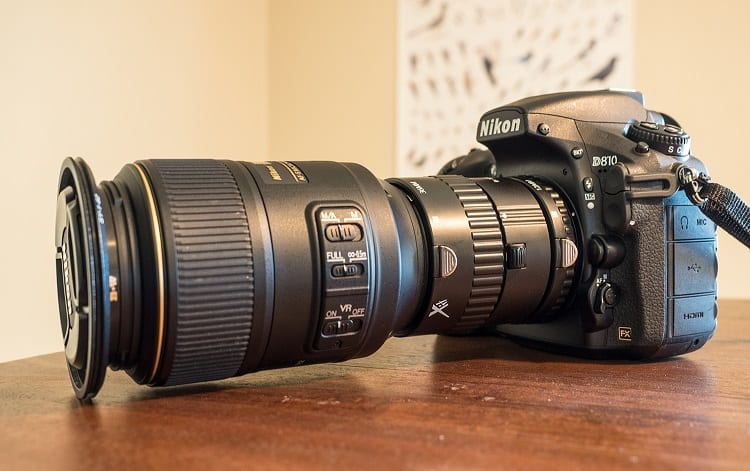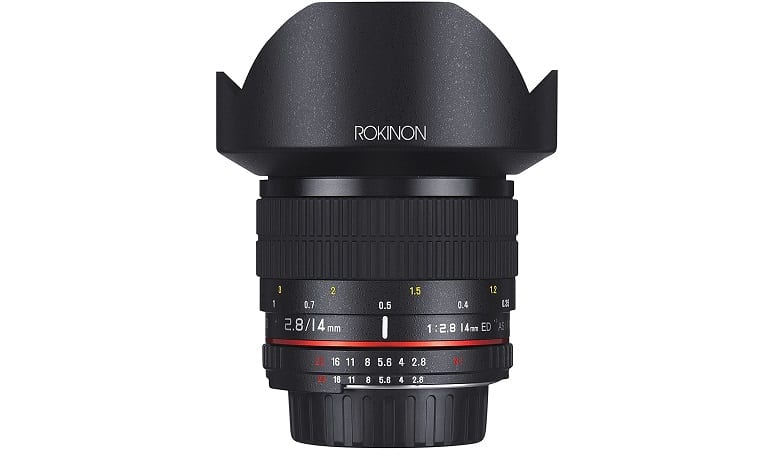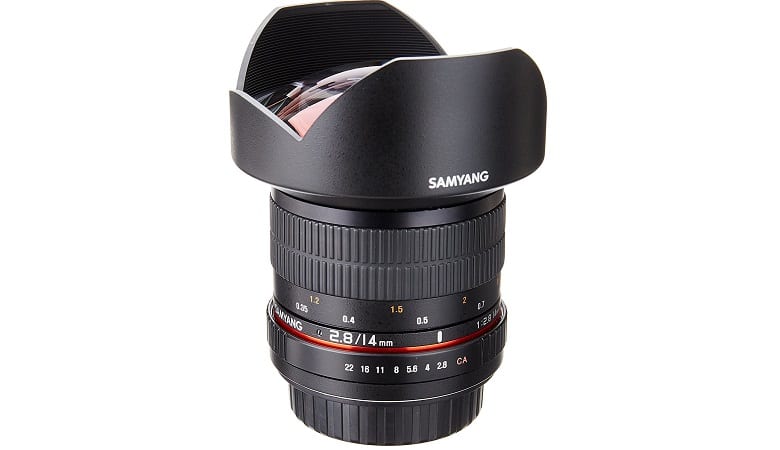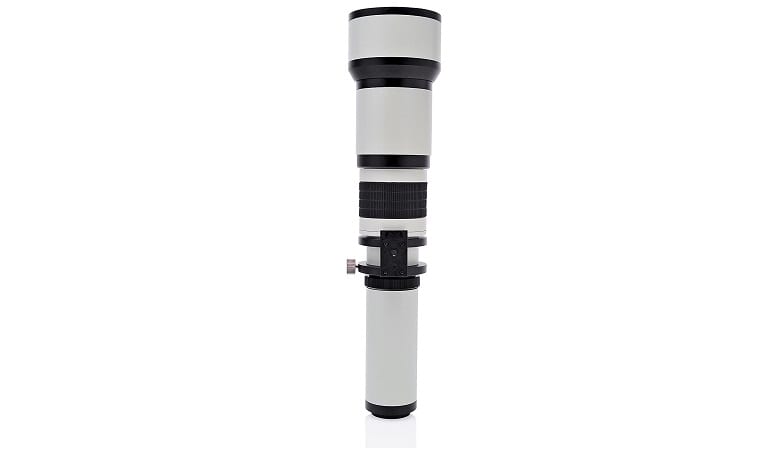Astrophotography isn’t always as easy as pointing your camera at the sky and taking photographs.
The truth is that there’s more to know than just the type of camera and telescope you should purchase: we’re talking camera lenses!
These make a huge difference in the quality of your images – they’re even more important than your camera type – but there’s more to consider when purchasing them than just the quality of the materials used in their construction.
What lenses do you need for astrophotography?
To take good pictures of the celestial objects you see in the night sky, you need high-quality lenses that should bring more light into the pictures and reduce distortions, to mention just two few important features.
Not sure what lenses you should purchase and from what company?
Don’t worry, we’ve got you covered. Here’s our guide to the best lens for astrophotography: getting that perfect shot ain’t easy but it’s certainly possible!
Now that we’ve looked at some specs of the best lenses for astrophotography, let’s explore all the lenses in greater detail so you can see exactly why they’re worth purchasing.
Best Lens For Astrophotography – Reviews & Buying guide for 2020
Best Overall: Rokinon FE14M-C Lens
When in doubt, choose this Rokinon ultra-wide lens. It’s made specifically to take landscape, real estate, and astrophotography pictures, so that’s already a good start. Let’s check out what it has to offer.
Featured specs
- 14mm Prime lens
- 90-degree viewing angle
- 0.28mm focusing distance
Benefits
- This lens is an ultra wide-angle 14mm lens. It offers a 90-degree viewing angle to create dramatic effects, thanks to its aperture range that goes from F2.8 to F22.
- The lens has a minimum focusing distance of 0.28mm for better close-up shots.
- To boost the light of your images and prevent distortion, this lens has a UMC Multi Coating that decreases ghosting and flare. Ghosting is when light reflects off the lens’s surface and is visible on the picture. Flare, on the other hand, is when light from a bright light, such as the sun, creates a reflection in the lens’s glass and this also affects the image.
- It’s got low coma, which makes it perfect for taking pictures of the night sky. Coma refers to how the rays of light in images don’t refocus to a certain point but instead flare out from it. So, what this means is that if you’re taking a picture of stars they won’t look like dots of light but comets with an unfocused trail of light behind them. That problem is avoided with the use of this best astrophotography lens.
- This is a prime lens. These types of lenses can be used in low visibility conditions and they provide sharper images despite the lack of light.
Drawbacks
- The lens has a spherical design and it contains a hood that’s integrated in it, but this makes using filters on the lens very tricky.
- People who have bought this lens have reported that the lenses vary in quality – sometimes they get good shots with them and other times not-so-good ones.
- Others have said that the lens is difficult to focus.
- There’s another problem with this lens that’s been noted by some reviewers: it creates moustache distortion. This refers to how straight and vertical lines sometimes seem to curve inward towards the frame’s center and then back outwards at the corner.
Extra Features
- If you like being in control of all the settings and features of your camera when you take pictures of the stars and planets, you’ll love that this lens is a full-manual one so you can do everything yourself to get the perfect shot.
- Even on a crop sensor camera, the lens is very wide and gives you a full field of view.
Buying Advice
This Rokinon lens is perfect when you want a wide view, such as when taking pictures of a galaxy of stars. It’s a lens that will go the distance when you need to take high-quality pictures of the universe.
Runner Up: Samyang SY14M-C Lens
If you want to feel like you’re stepping right into the astronomy pictures you’re taking, this Samyang lens is one to consider purchasing. It also has lots of useful features for beginner and advanced astrophotographers alike.
Featured specs
- Low coma
- Metal and polycarbonate plastic construction
- Responsive focus ring
Benefits
- This lens offers a 115.7-degree view angle. Its very wide-angle focal length can help you to get the scene in front of you in one frame. This is beneficial because it makes you feel like you’re right inside the image, so you’ll be immersed in your astrophotography.
- The components have been coated with anti-reflected UMC coatings so that it prevents internal reflections that can cause ghosting.
- It’s built to be durable. This lens is constructed out of metal and polycarbonate plastic. It also has a metal mounting plate.
- It’s got low coma. This prevents chromatic aberration and it makes it very useful for taking pictures at night.
- You can use this lens with a variety of cameras, such as mirrorless and DSLR cameras to achieve a 94-angle view, which is a bonus.
Drawbacks
- This lens is not zoomable, which might prove problematic, such as when you want to see more details on planets.
- If your eyesight is poor, it might feel impossible to focus this lens manually by looking through the viewfinder. This is because everything that you see in the viewfinder looks clear and sharp, so it’s misleading. As some people who have purchased this lens have reported, you’ll need to use magnified LiveView to ensure a sharper focus.
- Other people have reported their disappointment with how you can’t fit a filter on this lens. This could prove problematic for you during astrophotography if you intend on using color (or other) filters to get the best shots of the planets and stars.
Extra Features
- If you’ve previously battled with lenses that create distortions, you’ll love that this one is built to reduce the curvature of straight lines.
- This lens is a lot cheaper than what you’ll find in rival lenses that have the same focal length.
- The focus ring turns smoothly.
- The aperture ring is solid and stays put when you set it.
Buying Advice
This is a lens that’s very affordable and it’s packed with tons of features to take your astrophotography to the next level, so it ticks both important boxes.
Best lens for Nikon: Sigma 10-20mm f/3.5 Lens
While the previous lenses we’ve reviewed in our buying guide have features that promise to make your astronomy shots even more appealing, this lens by Sigma is the gold standard for astrophotographers. Here’s why.
Featured specs
- Color aberration prevention
- Multi-layer coating
- Hyper Sonic Motor
Benefits
- This lens allows you to achieve exaggerated perspective. What this means is that it has an ultra wide-angle lens that lets you produce exaggerated perspective between the background and subject of the image for more immersive shots.
- This lens has an aperture of F3.5. This creates bright, clear images in the viewfinder.
- This lens has Extraordinary Low Dispersion and Special Low Dispersion, both of which are glass components that prevent color aberration, so your image quality will always be improved when you use this lens.
- It has a multi-layer coating to prevent ghosting and flare. You can also make use of high-contrast images, no matter what zoom you’re using!
- Since it has a wide aperture of 3.5, this makes it very useful if you’re shooting in low-light situations, like when taking pictures of the planets at night.
Drawbacks
- Some people who have purchased this lens have reported that it’s not as sharp and focused as they would have liked.
- The autofocus feature of the lens tends to jerk a bit.
Extra Features
- This lens has a Hyper Sonic Motor, which means that you can achieve fast and quiet high-speed auto focus. Or, switch to manual focus by turning the focus ring. This versatility is great, especially if you’re a beginner.
- The lens comes with a petal-style hood that helps to block extra light from getting in the way of you achieving the perfect shot.
Buying Advice
This Sigma lens is available from various Amazon sellers. It’s quite pricey. However, it does have excellent features that are a dream to astrophotographers.
Best lens for Canon: Opteka 650-1300mm Lens
Now, on the Canon side of things, this Opteka lens is a solid choice. It has tons of benefits astrophotographers will love, such as when it comes to zooming into images. Let’s check it out!
Featured specs
- Anti-reflective coating
- Excellent zoom feature
- Tripod mount included
Benefits
- This lens uses six optical glass elements in five groups to decrease issues such as chromatic aberrations throughout the range of its aperture.
- It’s been coated with an anti-reflective coating that prevents ghosting and flare. This results in pictures that have more contrast and color fidelity.
- The lens is durable. It’s built with a full metal body and rear mount so it will be able to tackle wear and tear. This is important, especially because you’ll be using it outside a lot.
- You’ll be able to make use of its fantastic zoom feature that can be 650 to 1300mm or 1300 to 2600mm with the use of the 2x converter. This means that you can use this lens for a variety of activities, such as taking phenomenal moon shots.
- It comes with an in-built tripod mount that rotates so you can easily connect it to your monopod or tripod.
- The lens is made of optical glass that’s been diamond-cut. After being cut, the lens is ground before being polished.
Drawbacks
- Since this is a manual lens, it could be difficult to use if you don’t have experience with manual lenses.
- Some people have said that the lens is heavier than it looks and this makes it difficult to handle.
- Others have said that the quality of images produced by this lens are not that great when taken in low-light conditions.
Extra Features
- By using the T-mount that’s included in the pack, you can make the lens fit your camera system. This lens will work on full-frame and APS-C cameras.
- You get tons of other items that are included in the pack, such as the Opteka padded lens case that has a convenient strap and the aluminum lens hood.
- This hood prevents any stray light from entering the lens. It’s made out of durable anodized aluminum, so it will protect your lens if you happen to drop it or knock it against something.
- The hood also has a non-glare finish inside it, so as to prevent any reflections.
Buying Advice
It’s the best Canon-compatible lens for astrophotography and you’ll love how it can be used in a variety of different ways, therefore becoming a versatile lens for your collection.
You’ll also appreciate the fine attention that has been paid to its construction and features to make your astrophotography activity so much more enjoyable.
Best lens for Sony: Sony FE 16-35mm F2.8 GM Lens
If you love Sony, you’ll love this lens that gives you excellent corner-to-corner features to take your astrophotography up a notch. Not sure what that means? Don’t worry – let’s jump into its features to explain what makes this lens such a valuable one to own.
Featured specs
- G Master design
- Smooth bokeh
- Sony E-mount included
Benefits
- This lens has what’s known as a G Master design. This means that it produces a high resolution that doesn’t depend on the focus distance or zoom setting you use. Pretty neat, huh?
- It also has strong corner-to-corner contrast and resolution. This is perfect for shooting expansive subjects, such as a stunning galaxy that fills the frame.
- It has a 35mm view angle and the maximum aperture of F2.8 maintains the field depth as well as exposure.
- If you take pictures that are close to F2.8 you’ll be able to make use of smooth bokeh in the background. Smooth bokeh refers to a soft blur that’s created in the background, such as points of light or grass. This could be useful if you want to try a creative approach with your astronomy pictures.
Drawbacks
- Some people who’ve purchased this lens have stated that they dislike the softness that’s created at the corners of images. This obviously comes down to personal preference, though.
- Others have reported that when they used this lens with a filter, they found that they experienced vignetting. This refers to how the brightness and saturation tend to be reduced towards the peripheral edges of an image as compared to its center.
- One of the biggest drawbacks about this lens is that it’s considered to be quite overpriced.
Extra Features
- You’ll receive extra items in the pack, such as a hood, lens rear cap, lens front cap, a case, and a Sony E-mount.
- This lens is really light – it only weighs 1.5 pounds, so it’s extremely portable and convenient to carry as well as use. This makes it even more appealing if you’re looking for a grab-and-go lens that you can take on all your star-gazing trips.
Buying Advice
This Sony lens is quite expensive, but it does have features that can make it worthwhile, such as that it’s extremely versatile.
Astrophotography Lens FAQ
By now you probably have a better idea of what type of lens you should invest in for astrophotography, so let’s look at some questions regarding lenses and how to use them so that they’re as effective as possible.
What do I look for in an astrophotography lens?
If you want to buy a lens to use for astrophotography, you need to ensure that it won’t let you down when you’re out there taking pictures.
You don’t want to miss out on a spectacular view, after all. So, what should your astrophotography lens have to ensure it’s up for the job at hand?
Here are some important features to look for in a lens.
Focal Length
A lens that has a good focal length range is important. If you’re shooting pictures of the Milky Way, for instance, you’ll want to use a lens that’s 24mm or shorter if you’re using an APS-C camera or 35mm or shorter if your camera is of the full-frame variety.
If you’re taking pictures of planets, on the other hand, a focal length of 300mm or so is about right for taking pictures of planets and seeing some of their details.
Angle
A wide angle lens is superb in astrophotography because it creates a wider field of view so you’ll be able to frame more expansive subjects, such as galaxies.
Coatings
You need to pay attention to the type of lens coating. A cheap one will cause a lack of color vibrancy and contrast, making your images poor. You also want to avoid ghosting and halos from degrading your pictures. Coatings, such as anti-flare ones, are worth having in your lens.
Aperture
The aperture is one of the most important things to look for in your astrophotography lens. You want a lens with a good aperture range, as we’ve seen in our list of lens reviews.
With aperture, it can be a bit confusing because smaller numbers mean that the aperture is large, whereas the opposite holds true for larger numbers!
Aperture numbers like f/8 or f/16 are useful for landscape photography because they bring details to life with better clarity, both in the background and foreground.
For astrophotography, you want to have an aperture that’s f/2.8 or wider so that you can capture the brightest views. For deep-sky photography, you should still ensure that you use a wider aperture, but you should choose an aperture that’s approximately f/2.8 to f/5.6.
That said, you’ll have to take other factors into account, such as the dimness of the subject you’re photographing and the sharpness of your specific lens.
Can you use a macro lens for astrophotography?

Macro lenses are excellent to use for taking pictures of celestial objects. How they work is that they magnify the world and bring shapes and colors that aren’t that visible to life.
Basically, a macro lens will make the subject in your photo appear life-size. This is why it’s good to use a macro lens when you want to better see details of the night sky.
This type of lens has other benefits. When you take pictures of the stars, you want to ensure they show up as bright and clear, and a macro lens achieves this because it’s built to be a flat-field lens. This means that it’s sharp at the focal point, from the center to the edge.
In addition to the above, when you take pictures of the stars with a macro lens, you’ll find that the stars look round and they don’t have any distortions.
Ultimately, the stars that are at the corners of the image will have the same roundness as stars that are in the center, creating a more uniform and appealing image.
The macro lens is one of the most specialized lenses, because it helps to produce images that are larger than life. This is beautiful for use in astrophotography because you’ll be able to reveal breath-taking details of celestial bodies.
Is a 50mm lens good for astrophotography?
Generally, a lens that’s approximately 50mm is considered to be a good choice. For astrophotography in particular, this lens will be appropriate because of its benefits.
These include how 50mm lenses are suitable for shooting landscapes because they produce really sharp images – and that sharpness is definitely what you want to achieve when you’re shooting the vast expanse of a galaxy!
A 50mm lens also gives you the chance to take pictures of one part of the sky at night, which is also beneficial when it comes to taking photos of the constellations.
It also works with the Rule of 500 in photography (which we’ll get to in the next section), in that this rule sometimes means that you can’t maintain an exposure for longer than about 10 seconds without creating star trails.
A 50mm lens, however, enables you to do this as well as take photos that are highly detailed. In fact, the wider your lens when taking astronomy pictures, the longer you’ll be able to leave the camera shutter open without getting those trails.
What is the 500 rule in photography?
If you want to improve your astrophotography, you’ll want to know what the 500 rule is. Here’s the lowdown.
First, a bit of background: because the Earth is rotating, it looks like the stars are moving across the sky in long exposures.
Star trails can be formed, but if you want to see points of light in your images that mimic the way we see the stars with the naked eye, you can make use of the 500 rule.
The 500 rule is basically a calculation: 500 divided by the lens’s focal length = the longest exposure (measured in seconds) that you can use before stars start to trail.
This is the magic number to use. If you end up setting the shutter speed for time that’s longer than the calculation determined, this will result in you taking pictures of stars that look like trails instead of being defined points of light.
Now, there’s a slight problem with the above calculation that you should bear in mind – it will work for full-frame sensors but not crop sensors because doing so will result in blurry images.
Capture Landscapes offers a guide on how you can find the maximum shutter speeds (based on your focal length and crop factor) so you can use that to ensure you don’t go beyond the shutter speed. It’s definitely worth checking out.
How do you focus astrophotography?

When you take pictures of the sky, you need to ensure that your focus is excellent. This is essential no matter what you’re trying to photograph. How to improve your focus will depend on what instrument you’re using.
For instance, when using a camera lens, you’ll have to set it to manual focus mode. This is because stars are not bright enough to be captured with the camera’s autofocus setting.
But how should you focus your camera lens?
To do this, you should locate the brightest star you can see in the sky and then turn on the “live view” camera mode on your camera. This is useful because it enables you to see a live video on your display screen.
Pro tip: Some of the brightest stars in the sky to locate and focus on include Vega, Altair, and Sirius, so those are worth locating.
If you can see that the stars look smaller on your screen, then that’s a good sign you’re focusing properly. If you don’t see any stars, this could mean you’re out of focus because the light emitted by the stars is being blurred because they’re too spread out.
To ensure that you improve your focus, you should also ensure you have a stable tripod. This will prevent blurriness that occurs as a result of the camera shaking. This is of the utmost importance to prevent image degradation.
You can find some lenses that come with a tripod mount included, which makes it much more convenient to attach a tripod, such as the Opteka 650-1300mm (with 2X- 1300-2600mm) Telephoto Zoom Lens for Canon that we featured in our buying guide of the best astrophotography lens.
Conclusion
You might have a fantastic camera but you need a lens to really take your astrophotography to a higher level. No matter how great your camera is, the lens you use will make all the difference in the type of pictures you can achieve.
In this article, we’ve featured the best lens for astrophotography as well as four alternative products that make the most sense to purchase if you’re serious about taking stunning pictures of the universe.
We’ve also provided you with important photography terms and products you need to know and how to make the most of them when taking pictures of the sky, such as when it comes to macro lenses and the “500 rule.”
This will ensure that the lens you choose for astrophotography will work for you and create images that are as beautiful as what you can see in the sky through a telescope.














